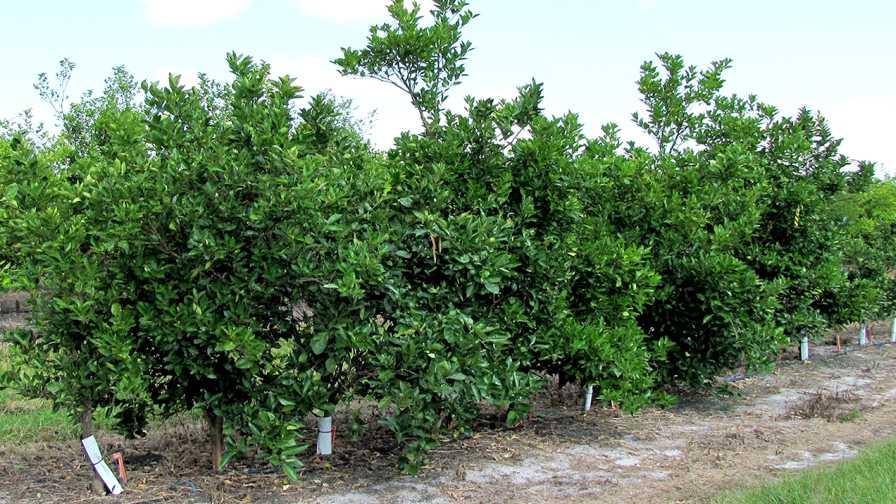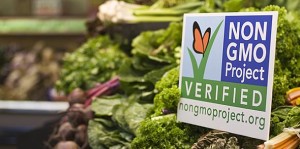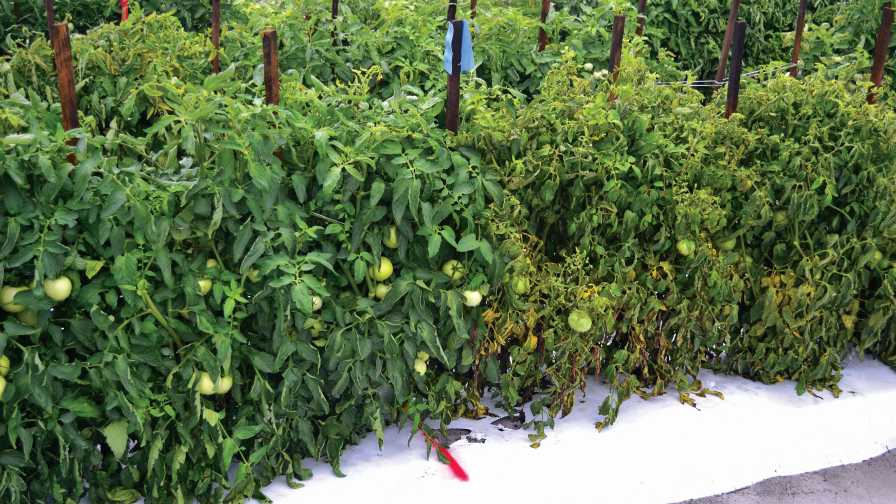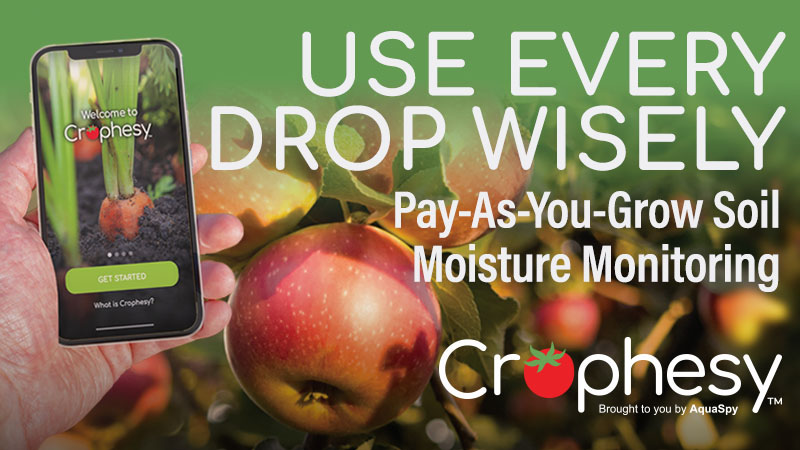GMO Solutions Waiting in the Wings for Specialty Agriculture

GMO citrus trees developed by UF/IFAS are disease free after six years in the field.
Photo courtesy of UF/IFAS
If you follow the debate over genetically modified organisms (GMOs), the debate between the pros and cons can be somewhat exhausting. It has been an argument that has raged for decades now, and it seems both sides are dug in deep and not likely to budge.
This leads many to unplug from the banter. Either consumers don’t care (and many don’t or don’t understand the issue), or those that do can find alternative like organics. While the majority of traditional row crop acres are genetically engineered (GE), there are not many specialty crops that incorporate the breeding technology. However, there are a few and there are other GE specialty crops waiting in the wings that would bring important benefits to growers.
The proliferation of grocery items carrying the Non-GMO Project butterfly label would indicate anti-GMO forces are moving the needle, if not from a scientific basis, but more from a marketing standpoint. While most scientific organizations have agreed GMOs are safe for years, the butterfly label is now on about $19 billion of products sold annually.
Fear of Backlash
Many of the companies that carry the Non-GMO label are most likely motivated by a perceived edge it might give from a marketing standpoint more than any concern of food safety for its consumers. But, the label in and of itself gives an implication there is a difference, and most consumers can only assume it relates to health and environmental sustainability — label equals good; no label equals bad.

Photo courtesy of the Non-GMO Project
That is a problem for researchers developing and breeding new crops that could yield significant benefits to growers and the consumers they feed. Take orange juice, for example, the Non-GMO label adorns the major juice brands in stores even though there is no GMO orange juice on the market. There is no reason to provide the label distinction for any other reason than marketing — because there is none. This is true for many other food and produce items.
As the Florida citrus industry enters its second decade fighting the plague of greening, GMO technology could be getting closer to providing breakthroughs in fighting the disease. Jude Grosser, a Professor of plant cell genetics at the UF/IFAS Citrus Research and Education Center, has a breeding program dedicated to finding a citrus tree tolerant or resistant to greening. Many agree this type of a find is the long-term silver bullet solution the industry needs to survive. Some of Grosser’s and his colleagues work involves genetic modification. Manjul Dutt, a UF/IFAS Horticultural Scientist, and Ahmad Omar, a UF/IFAS Molecular Biologist, are research collaborators with Grosser.
“We are working on producing GE trees that will resist greening,” Grosser says. “We are targeting genes that turn on the tree’s own defense system (systemic acquired resistance). We have one gene from Arabidopsis (from the mustard family) that is working, as plants have remained disease free now for six years in the field.”
Grosser and his team are now trying to stack genes to achieve long-term resistance. Should the greening pathogen develop resistance to one gene, there is another to back up efficacy.
“We are now producing transgenic plants that have two genes that work by different mechanisms to achieve this,” he says. “We also are producing resistant GE rootstocks in the hopes we can protect non-GMO scions, which would be more acceptable to the public.”
The scientists also are using genetic engineering to achieve early flowering. Juvenility is a big impediment to both conventional breeding and GMO breeding.
Dutt has developed a transgenic Carrizo rootstock expressing early flowering genes (18-month-old seedlings flower and set fruit). They are testing grafting hybrids from the breeding program on the rootstock to see if it is possible to speed up the breeding process.
Other research turned up a purple lime. Dutt has developed anthocyanin as a selectable color marker to replace GFP (the green fluorescent protein from jellyfish, which has not been deregulated). The markers are used to show genetic modification has taken place. Anthocyanin is what makes grapes purple and what gives blood oranges the red coloration. It is a nutrient and antioxidant that prevents cancer.
“A byproduct of this work is our purple limes, which might be a tool to help get consumers to accept GMO citrus,” Grosser says. “Purple margaritas anyone? Margaritas that are more nutritional and help prevent cancer could result in many new GMO-citrus fans.”
Finally, the team is studying gene editing and CRISPR breeding techniques that could resist greening and would not be considered a GMO plant. However, some anti-GMO groups are turning their attention toward this type of technology. Grosser says the anti-GMO attitudes being perpetuated by things like a Non-GMO project label are a concern because it potentially could impede the introduction of breakthroughs that could help Florida citrus growers.
“All three major orange juice companies have the non-GMO stickers on their orange juice bottles, so it is an issue,” he says. “It is hard to backtrack from labeling. Every plant or tree should be evaluated on its own merits. What is the cost benefit? What are the pros and cons? If a new tree proves to have no safety issues to the environment or to the public, then it should be acceptable regardless of how it was produced. We need to work hard to convince the public of this approach.”
Other research institutions like USDA and private companies have deployed GE technology in the quest to save the state’s signature crop. Once perfected, perhaps one of the biggest hurdles for the industry to overcome will be the public perception that has been created over the years by those who seek to stop the technology.

It is easy to spot the line where the bacterial spot-resistant GMO tomato ends and a conventional variety starts.
Photo courtesy of UF/IFAS
Beating Bacterial Spot
Florida is the No. 1 producer of fall and winter tomatoes in the country. Bacterial spot is among the more troublesome disease problems farmers face growing tomatoes that will stock the nation’s grocery stores during the cooler months. Often Florida growers must make many copper-based sprays to manage the disease at cost of nearly $100 million annually.
There is a solution to that problem growing in a research field in Central Florida. Sam Hutton, an Assistant Professor of tomato breeding and genetics at the UF/IFAS Gulf Coast Research and Education Center, has been trialing GMO tomato varieties resistant to bacterial spot. He says trials look good.
“The experimental hybrids have continued to look outstanding in our trials,” he says “These contain a bacterial-spot resistant gene from bell pepper (Bs2). Or, in some cases, this pepper gene together with an additional disease-resistance-gene (EFR) from Arabidopsis thaliana.
From a conventional breeding standpoint, Hutton says the best sources of resistance often are derived from wild tomato species, which presents a number of challenges to breeders seeking to incorporate this trait into commercial varieties. Additionally, conventionally-bred resistance is only partially effective — providing a reduction in symptom severity, but not immunity to the disease. In contrast, the GE hybrids often are symptomless (especially the two-gene stack), even under conditions of very high disease pressure. The result is a huge bump in marketable yields for the GM hybrids — often two-fold, when comparing GMO and non-GMO versions of the same hybrid.
“This bump in yield comes without the use of any pesticides to control the disease and without any additional water or fertilizer inputs,” Hutton says. “So, in effect, this technology has the potential to increase yields and reduce pesticide inputs, without increasing other inputs or the carbon footprint.”
Essentially, a fix for bacterial spot waits for approval as it moves through the regulatory process. Then the hurdle of consumer perception must be dealt with before bringing the technology forward to benefit the public and the environment. Hutton says it is difficult to say if growers would be willing to adopt the technology with strong the anti-GMO perception that persists today.
“The chances are probably bleak as long as this sentiment persists,” he says. “But I am hopeful that with a better understanding of GMOs in general, and this GMO in particular, the public would be more accepting of such crops. If so, we might one day see them come to market. I hope that day comes soon. It’s really hard to watch something be left on the shelf when it has so much potential.”










